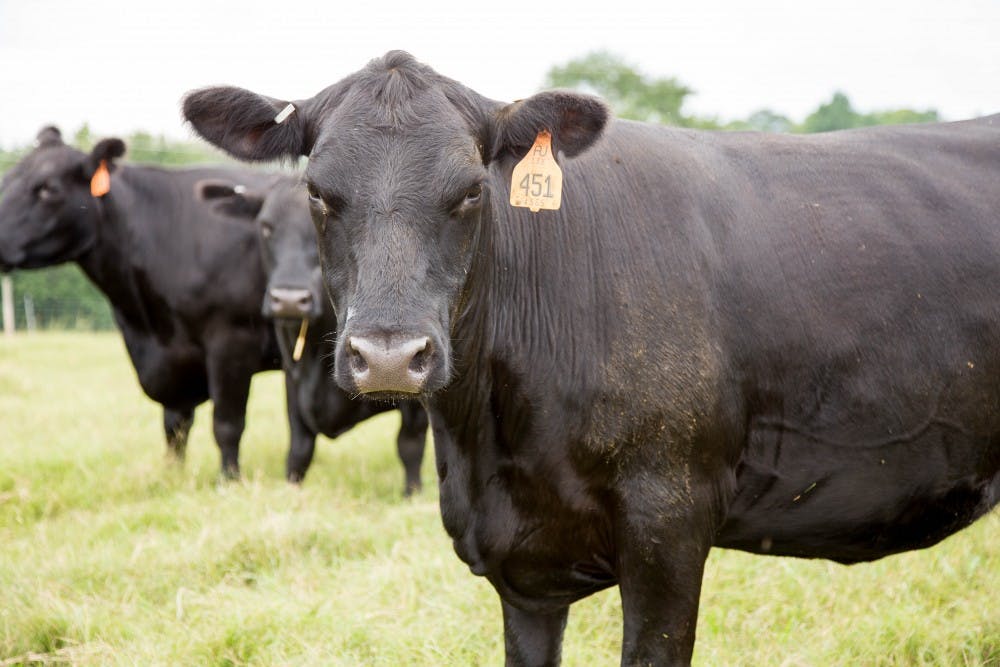Auburn University has served locally grown meat on its campus for five years; however, the University’s Beef Unit may be feeling the weight of the effects from the University’s growth.
George Richburg, manager of Auburn University’s Beef Teaching Center for the past 13 years, began his career at Auburn as a student where he worked in the beef unit. Shortly after graduating, Richburg came back to Auburn to be the manager of the Beef Center in 2006.
Richburg said he has been around cows since he was a young boy when his father purchased some for the family, recalling his father grew up on a farm.
Located beyond Shug Jordan Parkway is a glimpse at some of the roughly 160 cattle at Auburn.
The announcement and construction of the University’s new intramural fields has reallocated 30 of these acres.
While the University has purchased an additional 30 acres of land in return, the land was forested upon purchase and is in the process of being cleared.
Construction for the new fields on the former agricultural pasture land began this past fall.
“I now have 30 acres less land for about the next year to year and a half to try to maintain my whole cow herd on,” Richburg said.
He said while he will receive the number of acres he lost, the exchange has posed a challenge for him during this time between the University starting construction and when the new land is ready.
“It’s a challenge in the sense that our goal here is for [the cows] to eat grass; so when you take some of our available grass away, it’s going to make it a challenge,” Richburg said. “Our
input costs are high, so it’s probably going to drive those up for the next year or two as we have less available land space.”
Richburg said in the next two years it will be a lot harder to turn a profit.
He assured he will try to maintain the current conditions for the cows during the transition. While Richburg believes he will do whatever it takes to maintain these conditions, he notes it will come at a higher cost.
“Less land to graze on probably will lead to having to give them a grain supplement or extra hay supplement, which again, will drive our input costs up,” Richburg said.
Richburg said this kind of situation is not rare and something all farmers who do not own the land face.
“It’s just a struggle for any of our producers — our costs are very high, it’s labor intensive. Like here, we’re still on campus, campus grows so they look at nice open pasture land,” Richburg said. “It’s not just Auburn’s campus. But as populations grow, cities grow, you are expanding and encroaching on what has been utilized as agriculture in terms of farm production.”
Richburg said this is a counterproductive struggle for producers.
“We’re being kind of pushed and trying to produce a good healthy wholesome product for people to eat in our population that is growing, so we are trying to produce more food for more people. Yet, we are having to fight the battle [of less land],” Richburg said.
He said cattle producers in general attain small profit margins due to high input costs. He noted that increased costs for the consumer do not translate to profit return for the producer, saying a lot of producers struggle to be profitable on a yearly basis.
“We put in a lot of time and effort,” Richburg said. “I have 15 to 18 months of taking care of [the steer] and raising it, feeding it and in the end our net is going to be a few hundred dollars.”
Independent producers can feel these same effects but heightened without accessibility to the necessary equipment.
“Typically, the hardest part with that is finding a facility to have them harvest it and process,” Richburg said. “There are just not a lot of facilities.”
If Richburg was an independent cattle producer, he would have to drive to a facility hours away and be responsible for marketing his product to consumers on his own.
“Here it is part of the University,” Richburg said. “We have the facility here, [and] we have the store here where we sell meat.”
As manager of the herd, Richburg communicates with the manager of the Meat Lab, Barney Wilborn, to decide upon the treatment of the animals. The two are responsible for agreeing on the handling of the animals’ diet, vaccinations and regulations such as whether to follow organic or grass-fed restrictions.
“I have the unique situation where right next door is our actual harvest facility, and that’s not the case for most people throughout the state,” Richburg said. “Most people are going to have to drive some amount of distance to take their animals to be harvested and processed.”
The Meat Lab is responsible for the harvesting and processing of the animals and the selling of the meat. Richburg said he frequently meets with Wilborn to discuss enhancing the quality of the meat or the marketability of the product.
“We’re not trying to promote organic or all natural,” Richburg said. “We’re just trying to produce a good, healthy product.”
The University’s cattle are born during either the fall or spring season and remain with their mothers for six months, Richburg said. The calves are then separated by gender with steers , castrated bulls, grouped with heifers.
At around three to four months, the calves receive their first vaccination to help prevent against respiratory diseases. After a month, the calves will receive a booster to optimize their immunity, Richburg said.
“Outside of that, we really don’t give them anything else, unless they were to get sick, and then we treat them with some antibiotic that a vet would prescribe,” Richburg said. “We give them the vaccination as a prevention to keep them healthy.”
Richburg said animals will follow the course of treatment provided by the veterinarian and upon recovery will be processed for meat if not specified otherwise.
The steers, used as the primary source for meat, spend six months to a year grazing grass. After that year, feed or supplement will be added to their diet.
“Most of the time, our [supplement] is soy hull pellets and corn gluten pellets,” Richburg said. “Soy hulls are a byproduct of the soybean, and corn gluten is a byproduct of when they’re processing corn.”
Richburg said the corn provides fat for the animal that helps with marbling in the meat, which determines how flavorful and juicy it will be.
The steers will spend an additional year grazing grass until they are harvested at about 18 months old, Richburg said.
He said the cattle are not subjected to any chemicals directly. He noted usage of Roundup or other store-bought herbicides on the fence line of the grazing fields to prevent grasses and plants from growing and interfering with the electric fencing.
Richburg said he follows the guidelines and recommended usage on the labels of the products that denote any necessary length of time before processing.
Denying any effects on the humans who will later eat the meet, Richburg repeated that the herbicides are not in a protected class and could be purchased by anyone.
“The only time we would utilize giving a hormone would be when we’re trying to breed the cows,” Richburg said. “It’s not like we’re giving them a bunch of hormones or growth promotions.”
If the cow has difficulty with fertility, he said they will give her a shot of progesterone or another naturally occurring hormone to increase her chances of getting pregnant.
Richburg said he has around 60 mature cows and, on a yearly basis, has to give nearly half of them hormones to aid with their fertility.
Richburg denied these hormones cause any harmful effects on the humans who will eat the meat.
“My job here, first and foremost, is care of the animals, the cow herd,” Richburg said. “Second is to educate and teach the students about cow production and producing cattle.”
Richburg said the number of students choosing to study agriculture has been steadily increasing over the last 10 years. He noticed there is a growing trend of students with a non-farm background and female students pursuing the field.
“There are limited resources,” Richburg said. “As we’ve seen an increase in students does not necessarily mean we’ve seen a change in terms of resources available. That is a struggle here for us so that is a challenge the animal units, not just the beef unit.”
Richburg said while the University was founded as an agricultural University, it can feel that there are people who do not see the value in agriculture and its contributions to both the University and society.
“From the producer’s side, we’re producing this product, and we want it to be the best product we can possibly make for people,” Richburg said. “We would like to help feed our neighbors and people in our community.”
As a person in agriculture, Richburg said he tries to voice, stand up and fight for the field as he believes it is vital to society as a whole.
“We do it because we love it,” Richburg said.
Do you like this story? The Plainsman doesn't accept money from tuition or student fees, and we don't charge a subscription fee. But you can donate to support The Plainsman.





